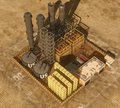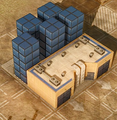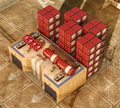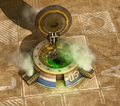Act of Aggression/USA Structures
The US Army advances through three tiers, starting at DEFCON 3 and proceeding to DEFCON 1. Each level unlocks additional research technologies and stronger units. Advancing to the next DEFCON level is done through the Headquarters building.
DEFCON 3 Structures[edit]
Field Headquarters[edit]
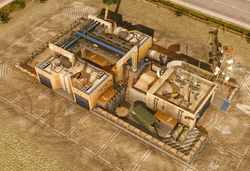 | |
| HP | 400 |
|---|---|
| Cost | |
| Upgrades | Green Zone |
| Special Notes | Stores 1500 units of resources. |

The Headquarters is the structure that works on constructing all the others. It also is able to produce Recon Teams to search for resources and scout enemy positions.
The Headquarters also generates 30 credits per second, ensuring you will never really run out of resources. It also stores 1500 units of aluminum, rare earth, or a combination of each. Ensure your Field HQ remains protected, as it is not only expensive but losing it results in losing all the resources stored at it as well.
The Field Headquarters can build all other structures, and can be built in turn by another Headquarters or a FOB.
-
At DEFCON 2
-
At DEFCON 1
Refinery[edit]
 | |
| HP | 150 |
|---|---|
| Cost | |
| Upgrades | Green Zone, Deep Mining, Hydrofracking |

Building refineries is key to extracting resources. It also produces M993 carriers to ferry the produced resources to the nearest Field HQ, LEM, or FOB for usage in other buildings. Refineries can only extract oil and aluminum; rare earth requires the processing plant.
The refinery automatically extracts from one resource node at a time, regardless of the number of resource nodes within its reach. The only way to improve this gathering rate (short of upgrades) is by the double refinery strategy. Resources extracted by the refinery are unusable until carried back to a LEM, Field HQ, or FOB structure by M993s. It is important to not have too many M993s, as having too many results in a long idle time for the carriers. The stock of a refinery can be determined at a glance by the number of crates stored in its loading bay (see the gallery).
The Refinery extracts at a rate of 14 units per second on a single node, which can be easily identified by having an extractor on it. The extractor itself is indestructible and only shows which of the oil or aluminum nodes the refinery is extracting from. The refinery extracts oil and aluminum at the same rate.
The Hydrofracking upgrade doubles the rate at which the refinery extracts from its node - from 14 resources per second to 28 resources per second. This increased resource gain may necessitate additional M993 units to carry the additional resources.
The Deep Mining upgrade, however, makes each resource node last longer by reducing the rate of extraction while keeping the resource gain on the refinery the same. With Deep Mining, an otherwise default refinery will extract only 7 resources from a node while still adding 14 to its stock.
Combining the two upgrades allows the US Army to build a large army using far fewer refineries. The two upgrades result in a refinery that extracts at 28 resources per second but only takes 14 resources from the refinery node. Researching these technologies early is key, as its usefulness declines with the number of available resource nodes.
-
Fully stocked (oil)
-
Fully stocked (aluminum)
Barracks[edit]
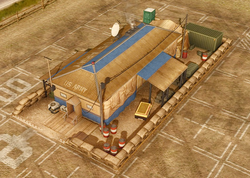 | |
| HP | 60 |
|---|---|
| Cost | |
| Upgrades | Green Zone |

The Barracks' role is to create infantry units. While extremely cheap, infantry are not the most durable of units and are easily killed by anti-infantry vehicles. Their biggest strength are the large numbers they can be deployed in, swarming larger enemy tanks with large volleys of missiles. They are even more dangerous when fortified in buildings.
LEM[edit]
 | |
| HP | 50 |
|---|---|
| Cost | |
| Upgrades | Green Zone |
| Special Notes | Stores 1500 units of resources. |

The LEM stores 1500 units (same as the Field HQ) of aluminum, rare earth, or a combination of the two. Additionally, the LEM expands the base construction zone, allowing structures to be built further away from the Headquarters. They must still be built close to an existing build zone, however.
Ensure your LEMs are well protected, as losing a LEM to enemy fire (or selling the structure) also loses whatever resources are stored there. A LEM's inventory can easily be determined by looking at the crates in its loading dock.
-
Fully stocked (aluminum)
-
Fully stocked (rare earth)
MG Nest[edit]
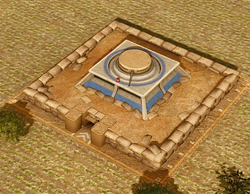 | |
| HP | 400 |
|---|---|
| Cost | |
| Upgrades | Green Zone, Defense Projection |

This defensive structure is a cheap and affordable structure capable of defeating modest infantry attacks. It requires aluminum to be upgraded to maximum capacity. A Barracks is required before MG Nests can be constructed.
Unlike the Sentinel Turret of the Chimera, the MG Nest cannot target inbound missiles or detect stealth units, necessitating protection from Phalanxes.
It is capable of receiving two upgrades to improve its effectiveness against tanks and aircraft, respectively, for 500 aluminum. The TOW 2 upgrade turns the MG Nest into an MG/AT Nest and equips it with a powerful anti-tank missile launcher.
The Stinger Post upgrade costs 500 aluminum and sharply improves its effectiveness against helicopters and aircraft. This turns the MG Nest into an MG/AA Nest and lets it benefit from the Stinger Block 2 upgrade.
Combining these two upgrades results in the Defensive Position. The MG Nest becomes a powerful anti-vehicle and anti aircraft defence that is also reasonably affordable.
With the Defense Projection upgrade from the Field HQ, the MG Nest is also capable of being deployed anywhere on the map. This makes them extremely useful when holding down chokepoints, or to try to wall in a turtling opponent.
-
With Stinger missiles
-
With TOW missile launcher
-
Fully upgraded
Field Generator[edit]
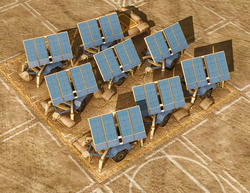 | |
| HP | 25 |
|---|---|
| Cost | |
| Upgrades | Green Zone |
| Special Notes | Produces |

A low tier power generator, the Field Generator is simply a large group of solar panels that work in any weather or lighting. It produces a modest 2 units of power to the base. Structures that require power will shut down if insufficient power is available.
The Field Generator must be built next to the Field HQ or a LEM, but will continue to function if the building it is attached to is destroyed. Strategic positioning of Field Generators around a LEM can result in up to eight at once.
The Field Generator is a prerequisite for constructing any structure that requires power, including the Light Vehicles Bay, Armory, and Logistical Center.
Light Vehicles Bay[edit]
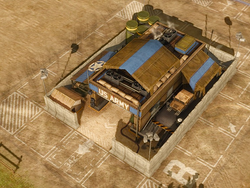 | |
| HP | 120 |
|---|---|
| Cost | |
| Upgrades | Green Zone |

The first vehicle production center available, the Light Vehicle Bay produces Humvees, all the Stryker variants, and the Blazer air defence vehicle.
It is also capable of upgrading Blazers so they can detect enemy stealth aircraft. This upgrade is highly important, as all fixed-wing aircraft except the Cartel's Valkyrie is stealthed.
Field Hospital[edit]
 | |
| HP | 120 |
|---|---|
| Cost | |
| Upgrades | Green Zone |

The Field Hospital heals nearby infantry, but it is mostly used as a detention center for prisoners. Any wounded infantry or enemy pilots captured will be sent here. Each prisoner grants 4 credits per two seconds and may be exchanged for 1000 aluminum or 250 rare earth. These exchanges are the chief way of gaining aluminum and rare earth once the map's resources are depleted.
The Field Hospital also grants an upgrade - Non-Lethal Tactics - that improves the chances of finding prisoners. This not only allows you to capture additional enemies, but also may distract your opponent by forcing them to commit resources to rescue large groups of pilots and wounded infantry late game.
Finally, the Field Hospital also may create Dustoff helicopters to heal and transport infantry.
Logistical Center[edit]
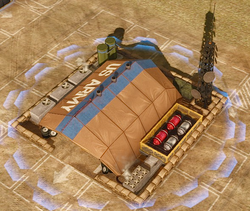 | |
| HP | 60 |
|---|---|
| Cost | |
| Upgrades | Green Zone |
| Special Notes | Repairs nearby buildings. Cannot repair itself. |

A must-have structure for its resource enhancement upgrades, the Logistical Center is key to any base. It has a wide range of upgrades that improve the base, including the Green Zone upgrade which improves building hit points. It also can deploy Hercules repair vehicles to keep your armoured vehicles in fighting condition.
The Logistical Center also repairs nearby structures. Depending on how large your base is, you may need to build multiple Logistical Centers to ensure your base can recover from attacks. Building at least one or two behind your MG Nests can keep them in fighting condition.
The Logistical Center cannot repair itself, but two can repair each other.
Armory[edit]
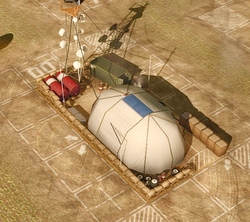 | |
| HP | 60 |
|---|---|
| Cost | |
| Upgrades | Green Zone |

The Armory's role is to provide military unit upgrades. Artillery upgrades such as White Phosphorous Rounds and the MRSI Targeting upgrade can be found here, but the real prize are the two TUSK armour upgrades. Obtaining the TUSK armour upgrades here allow them to be applied to your other vehicles, improving them and making them viable in the late game.
DEFCON 2 Structures[edit]
Power Plant[edit]
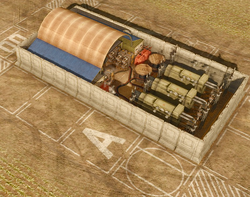 | |
| HP | 120 |
|---|---|
| Cost | |
| Upgrades | Green Zone |
| Special Notes | Produces |

An improved version of the Field Generator, this dedicated power plant produces more than enough power to finish building a base. Players will rarely need more than two of these structures. Power plants also unlock all power consuming buildings in the event the player did not build a Field Generator first.
FOB[edit]
 | |
| HP | 125 |
|---|---|
| Cost | |
| Upgrades | Green Zone |
| Special Notes | Stores 1500 units of resources. |

A cheaper version of the Field Headquarters, the FOB, or Forward Operating Base, acts as a dropoff point for distant refineries. Unlike the LEM, the FOB can be deployed anywhere on the map. FOBs can also produce another Headquarters building as well as a Barracks.
Similar to LEMs, FOBs create a build radius around them. Any structure can be built around the FOB, but the building must be built from a Field HQ.
Heavy Vehicles Bay[edit]
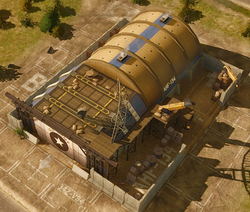 | |
| HP | 140 |
|---|---|
| Cost | |
| Upgrades | Green Zone |

The Heavy Vehicles Bay produces the M1 Abrams, the NLOS-C, and the HIMARS. Crucial to end-game combat, the Heavy Vehicles Bay has the highest power demands and a high up-front cost to match.
Helipad[edit]
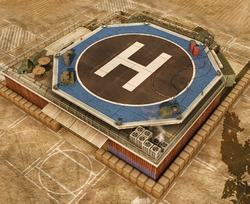 | |
| HP | 70 |
|---|---|
| Cost | |
| Upgrades | Green Zone |

The Helipad produces the Guardian, Little Bird, and Osprey helicopters. While not as essential as ground vehicles, helicopters are a good force multiplier and function extremely well as spotters for artillery units.
Air Control Center[edit]
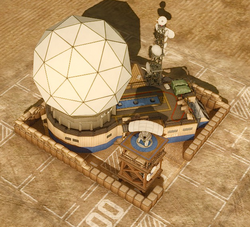 | |
| HP | 80 |
|---|---|
| Cost | |
| Upgrades | Green Zone |

This structure can produce and call in the American air force. The F-35B, F-22, and B-2 Spirit aircraft can be built here. Unlike other unit producing buildings, aircraft are built off-map and then called to fly in from an interface at the lower left of the screen. They will fly in, make their attacks, and then try to withdraw from battle. Aircraft are very expensive and can be easily destroyed by concerted surface fire.
Each Air Control Center can call in three aircraft of any type. Building additional Air Control Centers is necessary to call in more.
The Air Control Center also can be equipped with a radar to detect enemy aircraft entering the battlefield. This upgrade allows players to more accurately plan the interception of enemy aircraft with F-22s, and any player who uses F-22s should grab this upgrade as well.
Phalanx[edit]
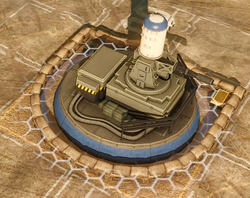 | |
| HP | 100 |
|---|---|
| Cost | |
| Upgrades | Green Zone |

The Phalanx is tougher than the MG Nest, can detect enemy stealth units and is more than capable of defeating small quantities of missiles within its range. It also deals good damage to aircraft and demolishes unlucky infantry in its proximity, although most other vehicles will take a beating. It may be wise to build multiple and back them with other units/structures as they can be overwhelmed easily. It's also worth noting that unlike the MG Nest, the Phalanx uses power to operate.
DEFCON 1 Structures[edit]
Processing Plant[edit]
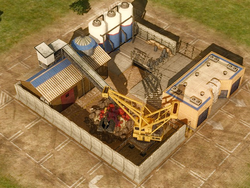 | |
| HP | 150 |
|---|---|
| Cost | |
| Upgrades | Green Zone, Hydrofracking |

Similar to the Refinery, the Processing Plant mines rare earth and also produces M993s to carry it back to the base. The processing plant, like the other refineries when mining rare earth, operates at an extremely slow rate: only 6 rare earth are processed per second. Otherwise, the processing plant follows the same logic and tactics that the other refineries require.
Although the description for the processing plant notes otherwise, the Deep Mining upgrade has no effect on the processing plant. The Hydrofracking upgrade doubles the rate of extraction from 6 units to 12 units per tick, but Deep Mining does not reduce the rate at which rare earth nodes are consumed.
Unique to the US Army, the processing plant has an upgrade which makes the plant produce credits equivalent to the amount of rare earth refined. This is a powerful upgrade if the plant can be kept active. At a cost of 1000 credits and at a rate of six credits per second, the processing plant needs to be kept alive for a little under three minutes of game time for the upgrade to pay itself off.
-
Fully stocked.
Accumulator[edit]
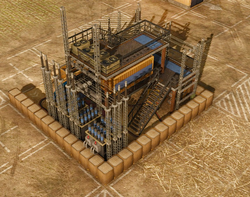 | |
| HP | 180 |
|---|---|
| Cost | |
| Upgrades | Green Zone |
| Special Notes | Produces Acts as emergency power battery in case of shortage |

The accumulator produces four units of power, but its primary purpose is to provide a backup power source in the event of a power failure. The top of the screen displays a battery that slowly empties; this battery represents the power held in the base's accumulators. This gives a US player the ability to quickly build a few field generators to help compensate for a sudden loss of power and keep Phalanxes, Patriots, and Peacekeepers functional.
The accumulator must be built next to a field generator or power plant, but will continue to function even if the structure it is attached to is destroyed or sold.
Administrative Center[edit]
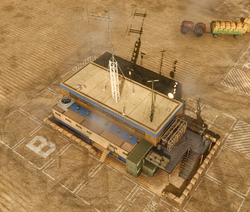 | |
| HP | 50 |
|---|---|
| Cost | |
| Upgrades | Green Zone |

The administrative center produces 20 credits every two seconds. While fairly expensive for what it is, building administrative centers is a useful method of converting aluminum to credits, which are used to build and upgrade the player's Abrams fleet. Aluminum is still useful in other units, particularly artillery, so players must balance their credits and aluminum carefully.
Administrative centers are extremely fragile and are pricey, so they must be protected for several minutes in order to recoup their costs.
Patriot[edit]
 | |
| HP | 60 |
|---|---|
| Cost | |
| Upgrades | Green Zone, PAC 3 |

The Patriot is a powerful anti-aircraft weapon and can can store up to four missiles in order to intercept enemy superweapons. Having at least one will prevent unnecessary losses, especially around more fragile structures than your headquarters as they usually cannot survive a superweapon strike. Although it can spot stealth air units, it has a very limited sight range and mostly relies on the assistance of other units and structures (such as an Air Control Center) to engage them.
The PAC 3 upgrade, purchased individually for each Patriot, increases its interception range, attack rate, accuracy and damage. As this primarily serves a defensive purpose, only a few Patriots would require it to protect the base against enemy aircraft.
Rare Earth LEM[edit]
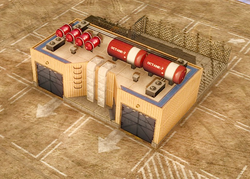 | |
| HP | 50 |
|---|---|
| Cost | |
| Upgrades | Green Zone |
| Special Notes | Stores 1500 units of rare earth |

Identical in all ways to the default LEM, the Rare Earth LEM only stores Rare Earth. This can be helpful for players who want to keep their rare earth stores protected, but otherwise the standard LEM stores both rare earth and aluminum at the same cost.
-
Fully stocked
Peacekeeper Missile Silo[edit]
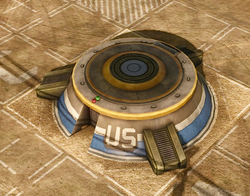 | |
| HP | 250 |
|---|---|
| Cost | |
| Upgrades | Green Zone |

The US Army's superweapon, the Peacekeeper tactical nuclear missile is capable of striking across the map against enemy positions and armies. The Peacekeeper causes a huge amount of damage, capable of eliminating any enemy unit caught in the blast as well as heavily damaging buildings. Proper knowledge of the target area's defences can prevent the missile from being intercepted by a superweapon defence structure or unit.
Peacekeepers can also be upgraded to Peacekeeper IIs for even more destructive potential and faster missile travel time.
-
Tactical missile ready.


